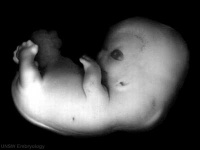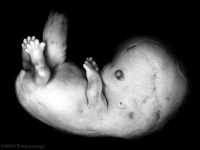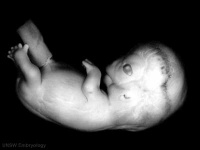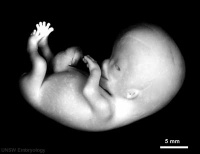Template:Week 8 Embryo Stages and Events table
| Week 8 - Human Embryo Stages and Events (GA week 10) | ||
|---|---|---|
| Embryo Week: Week 1 | Week 2 | Week 3 | Week 4 | Week 5 | Week 6 | Week 7 | Week 8 | Week 9 | ||
| Event | ||
| Stage 20 | 
Head scalp vascular plexus visible limb upper limbs begin to rotate ventrally neural - amygdaloid body has at least four individual nuclei[1] oculomotor nerve shows a dorsolateral and a ventromedial portion rhombic lip (rhombencephalon) formation of the cerebellum (intermediate layer) and of the cochlear nuclei cerebellum cell layer (future Purkinje cells) develops choroid plexuses of the fourth and lateral ventricles | |
| Gastrointestinal Tract anal (cloacal) membrane perforates | ||
| Stage 21 | 
neural - cortical plate appears in the area of future insula[2] limb upper and lower limbs rotate Intraembryonic Coelom pericardioperitoneal canals close | |
| Stage 22 | 
neural - neocortical fibres project to epithalamus, to dorsal thalamus, and to mesencephalon[2] limb fingers and toes lengthen Sense - Smell Stage 22 to early fetal period - migratory streams of neurons from the subventricular zone of the olfactory bulb towards the future claustrum[3] | |
| Genital 8 Weeks Testis - mesenchyme, interstitial cells (of Leydig) secrete testosterone, androstenedione
Genital 8 to 12 Weeks - hCG stimulates testosterone production Tongue Week 8 - nerves penetrate epitheilai basal lamina and synapse with undifferentiated, elongated, epithelial cells (taste bud progenitor cell) | ||
| Stage 23 |  Stage 23 defines the end of the embryonic (organogenesis) period Stage 23 defines the end of the embryonic (organogenesis) period
mesoderm heart prominence, ossification continues Head nose, eye, external acoustic meatus, eyelids, external ears, rounded head Body - straightening of trunk, heart, liver, umbilical cord, intestines herniated at umbilicus limb upper limbs longer and bent at elbow, hands and feet turned inward, foot with separated digits, wrist, hand with separated digits Extraembryonic Coelom chorionic cavity is now lost by fusion with the expanding amniotic cavity neural - rhombencephalon, pyramidal decussation present, nuclei and tracts similar to those present in the newborn cerebellum present as only a plate connected to midbrain and hindbrain through fibre bundles[4] axial skeleton vertebral column 33 or 34 cartilaginous vertebrae (20-33 mm in total length), vertebral pedicles, articular and transverse processes identifiable (no spinous processes)[5] | |
| Week 8 | stomach - Week 8 - Gastrin containing cells in stomach antrum. Somatostatin cells in both the antrum and the fundus. | |
| Note - the day timing of stages is only approximate, system names link to first page of that specific system, and events are based upon the literature cited below. | ||
References
| ||